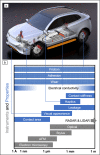Surface topography as a material parameter
- PMID: 36846501
- PMCID: PMC9947057
- DOI: 10.1557/s43577-022-00465-5
Surface topography as a material parameter
Abstract
Abstract: Materials science is about understanding the relationship between a material's structure and its properties-in the sphere of mechanical behavior, this includes elastic modulus, yield strength, and other bulk properties. We show in this issue that, analogously, a material's surface structure governs its surface properties-such as adhesion, friction, and surface stiffness. For bulk materials, microstructure is a critical component of structure; for surfaces, the structure is governed largely by surface topography. The articles in this issue cover the latest understanding of these structure-property connections for surfaces. This includes both the theoretical basis for how properties depend on topography, as well as the latest understanding of how surface topography emerges, how to measure and understand topography-dependent properties, and how to engineer surfaces to improve performance. The present article frames the importance of surface topography and its effect on properties; it also outlines some of the critical knowledge gaps that impede progress toward optimally performing surfaces.
Keywords: Adhesion; Contact mechanics; Friction; Roughness; Surface topography.
© The Author(s) 2022.
Conflict of interest statement
Conflict of interestOn behalf of all authors, the corresponding author states that there is no conflict of interest.
Figures



Similar articles
-
Deformation-dependent gel surface topography due to the elastocapillary and osmocapillary effects.Soft Matter. 2024 May 1;20(17):3676-3684. doi: 10.1039/d4sm00139g. Soft Matter. 2024. PMID: 38623818
-
Inversion of friction anisotropy in a bio-inspired asymmetrically structured surface.J R Soc Interface. 2018 Jan;15(138):20170629. doi: 10.1098/rsif.2017.0629. J R Soc Interface. 2018. PMID: 29298956 Free PMC article.
-
Modeling the surface topography dependence of friction, adhesion, and contact compliance.MRS Bull. 2022;47(12):1221-1228. doi: 10.1557/s43577-022-00468-2. Epub 2023 Jan 18. MRS Bull. 2022. PMID: 36846502 Free PMC article. Review.
-
Friction Behavior of Rough Surfaces on the Basis of Contact Mechanics: A Review and Prospects.Micromachines (Basel). 2022 Nov 4;13(11):1907. doi: 10.3390/mi13111907. Micromachines (Basel). 2022. PMID: 36363928 Free PMC article. Review.
-
[Effect of printing orientation on physical and mechanical properties of 3D printing prosthodontic base resin materials].Beijing Da Xue Xue Bao Yi Xue Ban. 2024 Apr 18;56(2):345-351. doi: 10.19723/j.issn.1671-167X.2024.02.023. Beijing Da Xue Xue Bao Yi Xue Ban. 2024. PMID: 38595256 Free PMC article. Chinese.
Cited by
-
Microbiological Evaluation of Thermoplastic PETG Dental Appliances Related to Surface Characteristics.Polymers (Basel). 2024 Aug 20;16(16):2354. doi: 10.3390/polym16162354. Polymers (Basel). 2024. PMID: 39204574 Free PMC article.
-
Tuning Surface Adhesion Using Grayscale Electron-beam Lithography.Langmuir. 2024 Jul 16;40(28):14257-14265. doi: 10.1021/acs.langmuir.4c00669. Epub 2024 Jul 1. Langmuir. 2024. PMID: 38949567 Free PMC article.
-
Evaluating scanning electron microscopy for the measurement of small-scale topography.Surf Topogr. 2024;12(3):10.1088/2051-672x/ad49b9. doi: 10.1088/2051-672x/ad49b9. Surf Topogr. 2024. PMID: 39896093 Free PMC article.
References
-
- R. Aghababaei, E. Brodsky, J.-F. Molinari, S. Chandrasekar, MRS Bull.47(12) (2022)
-
- T.D.B. Jacobs, T. Junge, L. Pastewka, Surf. Topogr. Metrol. Prop.5, 013001 (2017)
-
- T. Candela, F. Renard, Y. Klinger, K. Mair, J. Schmittbuhl, E.E. Brodsky, J. Geophys. Res.117, B08409 (2012)
-
- J. Allison, D. Bahr, S. Baker, E. Cerreta, N. Chawla, M. DeGraef, D. Dimiduk, J. Erlebacher, J. Evans, K. Fahey, K. Findley, E. George, D. Gianola, P. Gumbsch, G.R. Gray III, C. Handwerker, E. Holm, W. Jones, S. Kalidindi, S. Kang, D. Lados, R. LeSar, C. Levi, J. Lewandoski, D. Lewis, Q. Li, Z.-K. Liu, M. Manuel, E. Marquis, M. Mills, A. Mottura, B. Mueller, R. Odette, V. Ozolins, T. Pollock, B. Reynolds, A. Rollett, M. Sangid, T. Schaedler, C. Schuh, D. Shih, E. Taleff, D. Trinkle, A. Van der Ven, K. Vecchio, P. Voorhees, Emerging Science and National Priorities in Metals and Metallic Nanostructures (National Science Foundation, Washington, DC, 2012)
Publication types
Grants and funding
LinkOut - more resources
Full Text Sources
